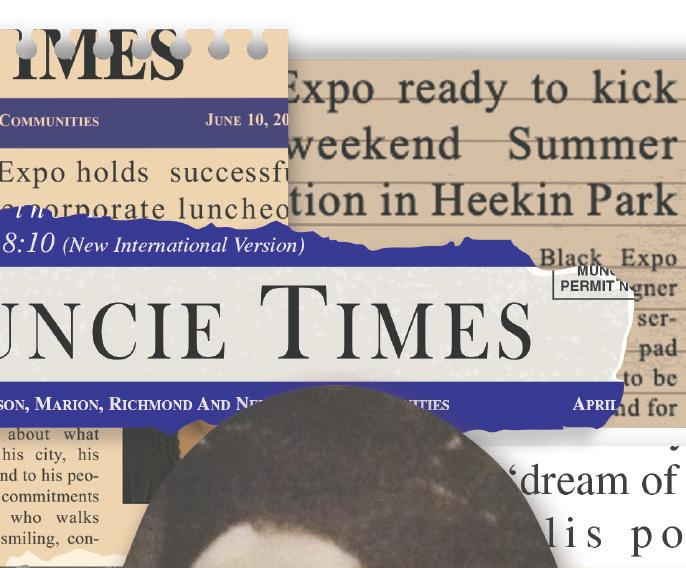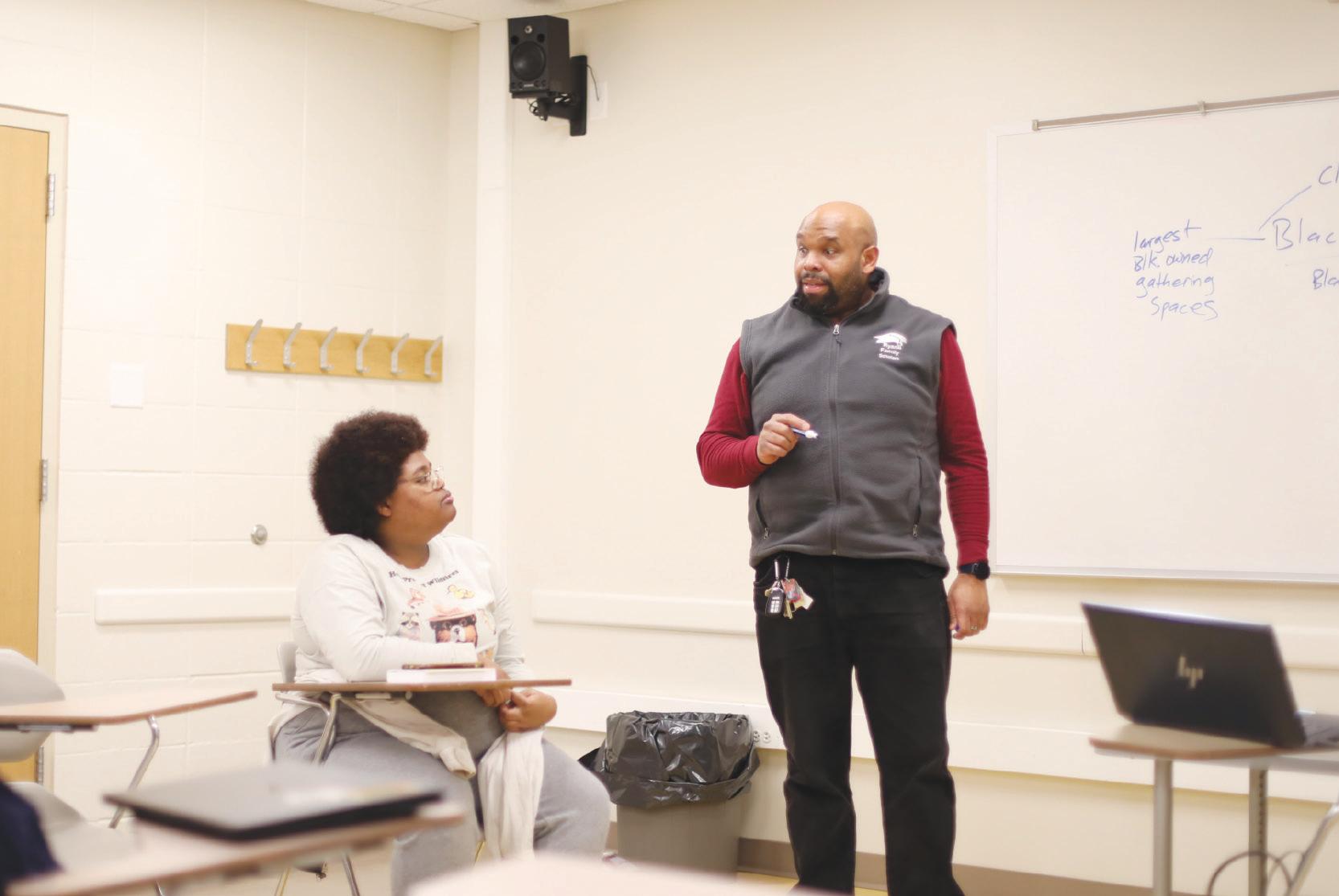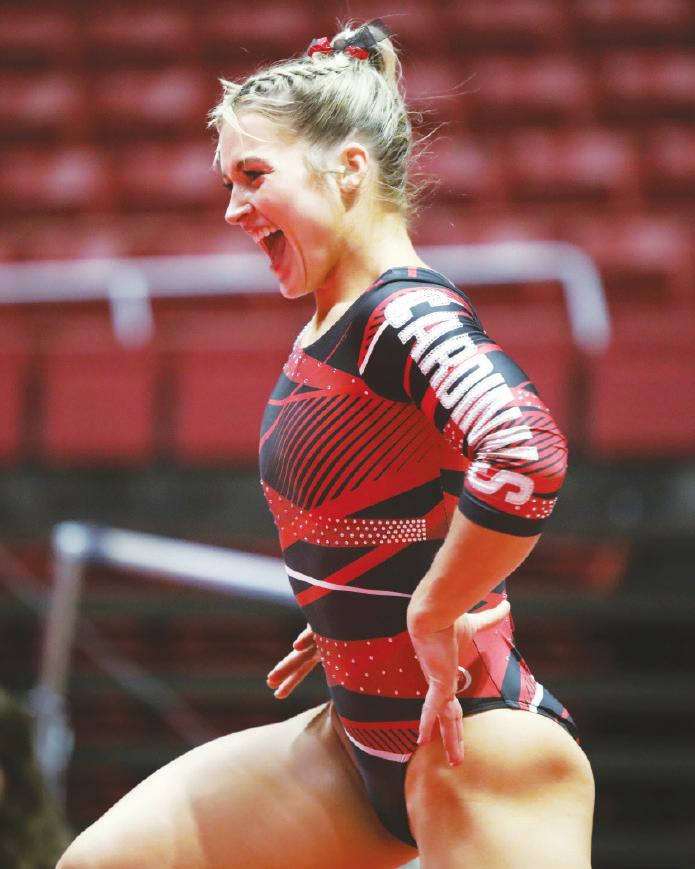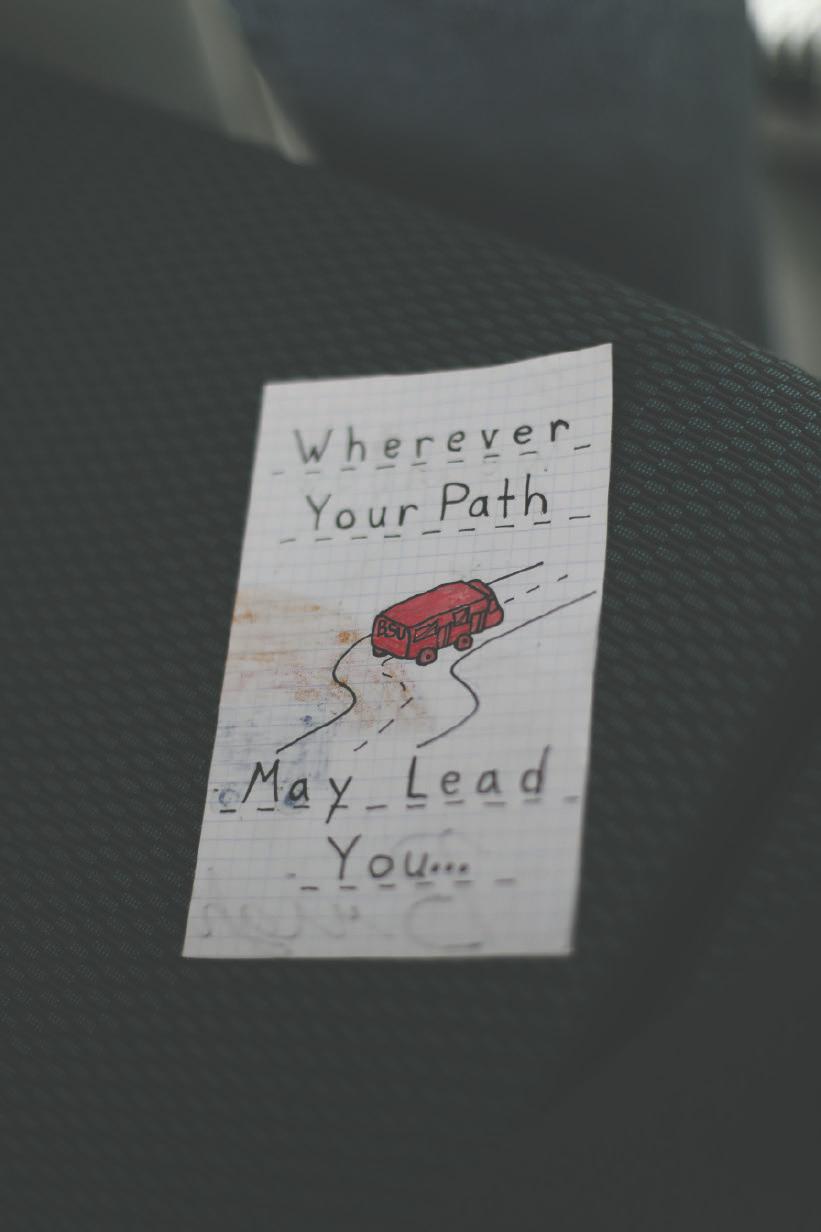Black
Black





























































































Late Monday evening, Michigan State University (MSU) issued a “shelter-in-place” order to students as they received reports of an active shooter on campus. After opening fire in areas on campus such as Berkey Hall and MSU Union, the gunman was identified as 43-year-old Anthony McRae. He was later found dead of a self-inflicted gun wound.

Feb. 14: Indianapolis has selected Philadelphia Eagles’ offensive coordinator Shane Steichen to lead the team. Steichen was selected from a process that took over a month and involved more than a dozen candidates. The Colts’ last hire from the Eagles was Frank Reich, offensive coordinator that went to the Super Bowl in 2018.
Payton Gendron, 19, killed 10 Black people at a Tops Friendly Market May 14, 2022. During the sentencing, a victim’s family member who was in the audience rushed at Gendron, only to be quickly restrained. Other members of families affected also spoke prior to the sentencing. The victims ranged in age from 32 to 86. In November 2022, Gendron pleaded guilty to charges including murder and domestic terrorism motivated by hate.

VOL. 102 ISSUE: 22
CONTACT THE DN

Newsroom: 765-285-8245
Editor: 765-285-8249, editor@bsudailynews.com
EDITORIAL BOARD
Elissa Maudlin, Editor-in-chief
Evan Chandler, Print Managing Editor
Angelica Gonzalez Morales, Digital Managing Editor
Kyle Smedley, News Editor
Hannah Amos, Associate News Editor
Daniel Kehn, Sports Editor
THURSDAY
FRIDAY
SATURDAY
SUNDAY
The Ball State Daily News (USPS144-360), the Ball State student newspaper, publishes Thursdays during the academic year, except during semester and summer breaks. The Daily News is supported in part by an allocation from the General Fund of the university and is available free to students at various campus locations.
Corbin Hubert, Associate Sports Editor
Lila Fierek, Lifestyle Editor and Copy Director
Mya Cataline, Associate Lifestyle Editor
Grayson Joslin, Opinion Editor
KwaTashea Marfo, Associate Opinion Editor
Amber Pietz, Photo Editor and Visual Editor
Jacy Bradley, Associate Photo Editor
Jacob Boissy, Video Editor
Olivia Ground, Social Media Editor
Alex Bracken, Visual Editor
Josie Santiago, Visual Editor
Lisa Renze-Rhodes, Adviser
The Daily News offices are in AJ 278, Ball State University, Muncie, IN 47306-0481. Periodicals postage paid in Muncie, Indiana.
TO ADVERTISE Call 765-285-8256 or email dailynewsads@bsu.edu between 8 a.m. to 5 p.m. Monday - Friday or visit ballstatedaily.com/advertise.
TO SUBSCRIBE
Call 765-285-8134 between 9 a.m. to 3 p.m. Monday - Friday.

Subscription rates: $45 for one year. POSTMASTER: Send address changes to The Daily News, AJ246, Ball State University, Muncie, IN 47306.
TO DONATE Visit BallStateDailyNews.com.
JOIN THE DAILY NEWS

Stop by room 278 in the Art and Journalism Building. All undergraduate majors are accepted and no prior experience is necessary.
The Ball State Daily News is committed to providing accurate news to the community. In the event we need to correct inaccurate information, you will find that printed here.
To submit a correction, email editor@bsudailynews.com.
THUNDERSTORMS
Hi: 62º
Lo: 26º
MOSTLY CLOUDY
Hi: 32º
Lo: 16º
MOSTLY SUNNY Hi: 43º


Lo: 29º
SUNNY Hi: 49º Lo: 37º
THIS WEEK: A drier and cooler weekend signals a return to seasonable weather next week, as high temperatures remain in the 40s throughout the week, before rain chances increase as we head further into the work week.
Waking Up with Cardinal Weather is Ball State University’s first and only morning mobile show focused on getting your ready for the day through local news, weather and lifestyle trends. Waking Up with Cardinal Weather airs every Friday morning at 8 a.m. at @cardinalwx live on Facebook.



The head-on collision happened Feb. 14, and authorities believe alcohol was involved. They stated a person was driving a truck southbound on Tillotson Avenue, and the deputy was heading northbound. The truck then crossed the raised center divider and hit the deputy on the front driver’s side. The Muncie Police Department are investigating the crash.
Feb. 3, around 50 train cars, including 10 carrying hazardous chemicals, were derailed in East Palestine, Ohio, releasing toxins into the air, endangering the public. Crew set five of the tanks releasing chemicals on fire, creating a thick black smoke in the area. Now, states like West Virginia are taking precautions to ensure their drinking water is safe.
Haley, the former South Carolina governor and United Nations ambassador, announced Feb. 14 she’s challenging Donald Trump for the 2024 Republican nomination. She announced her candidacy in a Twitter video. If elected, Haley would be the first woman and person of Indian descent to be president.


31%
“It was hard because after 21 years, you’re just used to certain things being done a certain way,” he said. “It just seemed like there was no organization in the civilian world.”
When American veterans come out of military service, there are some services offered to them. If they get injured, there are programs for them. Some get awards or medals for their service, but one thing still being worked on today is their mental health.
According to the RAND Center for Military Help Policy Research, an estimated 31 percent of veterans who served in either Iraq or Afghanistan experienced a mental health condition. The site also reports 18.5 percent of all returning service members meet the criteria for post traumatic stress disorder (PTSD) or have depression.
Another RAND study showed members of the Marine Corps ranked highest in depression, anxiety and smoking. Overuse of prescription drugs and PTSD were the highest in the Army.
Current bills in the Indiana State House are trying to give veterans some help. For example, Senate Bill 1 would help Hoosier veterans get service for their mental health. The bill would aim to have more benefits and programs for mental health. The bill would also establish and maintain a help line.
“It’s good to see how mental health is being prioritized,” Chaplain Kent Lundy said via email. “Prioritization is a good thing for service members, veterans and society as a whole.”
I think mental health is a hidden wound. You can go for years and not realize you have a problem and then, all of a sudden, it can flare out. So I think we owe it to our veterans to continue to help
Lundy, who has been a chaplain with the Air National Guard for 16 years, believes the outlook on the mental health stigma should shift directions.
“I would like to see the overall stigma associated with receiving mental health care be lowered,” he said via email. “I think we could all benefit from empowering those that need mental health services to do so without shame.”
As a chaplain, Lundy provides help for servicemen and their dependents. He is a United Methodist pastor who provides for any and all protestant airmen. If a service member of another faith or religion comes to him, he helps find a chaplain for them.
“If a service member or veteran came to me in a mental health crisis, I would make sure they pay attention to all four pillars of comprehensive Airman fitness [physical, social, mental and spiritual],” he said via email. “Once I know that person is safe at that moment, I would do a ‘warm handoff’ for them to get follow-up care.”
William Frederick, an Army veteran who served three years in the Vietnam War, remembered how he handled the transition from the battlefield to everyday life.
“It took me two years to adjust,” he said. “I kind of locked everything up and put it in the closet. I worked six days a week from sun-up to sun-down.”
One way Delaware County veterans find help with mental health is through the American Legion, in which Indiana has 400.

The Muncie location, Post 19, is a place for veterans to hang out. They have pool tables, a bar and many more activities for people to do, and they have a Facebook account where they update their events.

One of the ways the Legion helps is with their “commander’s breakfast.”
It is served once a month, and the menu is always the same: biscuits and gravy, scrambled eggs and hashbrowns.
Two years ago, Jesse Casperson was voted as the captain at the Legion. He was in the Marine Corps for 21 years and retired from Camp Pendleton, California. He believes his routine was the toughest part of getting re-introduced to the everyday world.
Casperson said mental health for veterans is a different kind of injury.
“I think mental health is a hidden wound,” he said. “You can go for years and not realize you have a problem, and then all of a sudden, it can flare out. So I think we owe it to our veterans to continue helping them.”
Another Marine Corps veteran Larry Barnes served for 37 years and started serving during the Vietnam War. He had some advice for servicemen who are just now getting out.
“Certainly join a group like [American Legion],” he said.
Casperson agrees with Barnes and thinks the Legion is a place where veterans can discuss their issues with fellow veterans.
“It’s a place that veterans can go where if they want to talk, we can talk to them,” Casperson said. If they don’t want to talk, we just show them the camaraderie and welcome them aboard.”
For more information about the Legion, visit their website. Muncie also has a Veterans Affairs. For more information about them, here is their website.
Contact Zach Carter with comments at zacharym
of veterans who served in either Iraq or Afghanistan experienced a mental health condition.
18.5%
of all returning service members meet the criteria for post traumatic stress disorder (PTSD) or have depression.
Source: RAND.org
American Legion.
them.”
- JESSE CAPERSON,Marine Corps veteran and current captain at
American Legion Post 19The bartender takes orders from the veterans as they sit at the bar inside of the American Legion Feb. 1. STEPHANIE MORTON, DN The American Legion sign hangs outside the American Legion Building Feb. 1. STEPHANIE MORTON, DN
It took me two years to adjust. I kind of locked everything up and put it in the closet. I worked six days a week from sun-up to sun-down.”
- WILLIAM FREDERICK, Vietnam War army veteran
Rihanna performed 12 songs during the halftime show of Super Bowl LVII. She came on stage with a baby bump, and after the performance, her representatives confirmed she is pregnant with her second child with A$AP Rocky. Following the halftime show, Rihanna’s streams surged 640 percent on Spotify and 331 percent on Apple Music.
A Ball State bus driver says goodbye to students and faculty after five years.

Cornerstone Center for the Arts is holding the Rock and Roll Trifecta Feb. 18 with the doors opening at 5 p.m. The concert has three bands: Mike Milligan and the Steam Shovel, Pushing Daisy’s Band and The Why Store. The concert goes from 6-11:30 p.m. with presale tickets going for $15 and day of concert tickets costing $20.
A new exhibit at The
and
Art Gallery opened Feb. 15. The 88th annual juried student art show will be open until March 16. The art show previews students’ work from the previous year. The gallery will be open from Tueday to Friday from 10 a.m.- 4 p.m. It will also be closed over spring break.

work with her. He said he’s been able to see first
Olivia Ground Social Media EditorHe greeted every single person who stepped foot on the bus with a smile.
He knew multiple students by name. He knew their major, their schedule and where they were headed. He knew their plan for the day and what they were doing that evening. He knew when they were graduating, how their extracurriculars were and what they planned to do after school.
He took care and pride in keeping students safe,
part about this job is the students.
“I love talking to [students], finding out different majors. I always talk to everybody. I’m a people person. The students are my favorite part,” Kemp said.
He shared a story about a student who lost their wallet and phone on a bus. Kemp went out of his way after a shift to return the objects after his route.
“I try to be me and just treat people like they want to be treated, and I want to be treated good,” Kemp said, “Since I want to be treated good, I try to treat everybody else good.”
The time he’s taken to go above and beyond in his interactions with students hasn’t gone unnoticed.
The students left him a card expressing their thanks. It read, “We are blessed to have a driver like you at Ball State!”

The driver’s dedication to the Ball State community was recognized by President Mearns in his Fall Convocation remarks in 2020. Mearns received positive emails from students about Kemp and other drivers on campus.
“Brian’s dedication exemplifies our individual and collective commitment to excellence,” Mearns said in his remarks.
Kemp was appreciative of the recognition and said it was an honor. He has lived in the Muncie community all of his life, and he graduated from Muncie Central in 1998.
Kemp’s mother worked at Ball State for 30 years. She was a custodian who helped clean
Ball State bus drivers aren’t paid in the summer, said Kemp. Additionally, he felt like he wasn’t making enough.
I love talking to [students], finding out different majors. I always talk to everybody. I’m a people person. The students are my favorite part.”
- BRIAN KEMP, Former Ball State campus shuttle driverhand the way campus has changed over the years. He is able to recount how even the number of students changed during the COVID-19 pandemic.
Outside of driving a campus shuttle, Kemp is a bus driver for the Muncie Community Schools district.
He is also a minister at Greater Mt. Calvary Church of God In Christ in Muncie. For Kemp, his main desire in life is to have a church, a dream he has had since he was 14 years old.
“It’s kind of fun that I get to minister to people all over,” Kemp said.
Kemp said he uses his interactions in both church and campus to try and teach students about financial literacy and smart spending. Kemp is a fan of Dave Ramsey and likes to share some of those ideas with students, he said.
“I believe you really need to earn money, especially in the Black community,” Kemp said. “A lot of people don’t know how to budget what they’re going to spend … it’s important to get their
“You don’t get paid in the summer, and when you don’t get paid in the summer, and you [have] bills, it’s hard to pay,” he said.
According to a Ball State job posting, a campus bus driver makes $19.38 an hour, and a .25 cent premium is added to second-shift drivers. The hours would be 2:45-11:45 p.m. Monday through Thursday and 11:30 a.m. -5:30 p.m. on Friday.

If a driver were to drive all those hours, they would make a biweekly take-home pay of $1,626.24 before taxes.
According to Living Wage Calculator, for someone of Brian’s living situation of having one income and one child, he would need to be making $31.47 an hour to have a livable wage in Delaware county.
Kemp said using Ramsey’s financial advice helped him buy a house. However, money doesn’t come easy.
Notes from students who rode on former Ball State bus driver Brian Kemp’s bus sits on a seat Feb. 8. JACY BRADLEY, DNStudents at Ball State University created a fundraiser on GoFundMe for former Ball State bus driver Brian Kemp.







The red-carpeted staircase in the Bethel African Methodist Episcopal (AME) Church in Muncie, Indiana, leads to a collection of artifacts that tell the story of the church.

The downstairs area is called the Julia Bass Fellowship Hall, named after a member of the church who served as a missionary and was a mother of the church.
“Mothers of the church would lead young women and guide them on how to be involved in the church,” Ed Faulkner Jr. said.
Faulkner has been a lifelong member of the Bethel AME Church; his father, Ed Faulkner Sr., was a trustee at the church.
The Fellowship Hall contains other snapshots of history, such as photographs of the groundbreaking ceremony of the current church in 1979 and a Bible dated July 11, 1926, with signatures of the members of the church inside.

Looking through the many photos in the Fellowship Hall, Faulkner Jr. sees photos of children who were in Sunday school at the church. He said he is in some of the photos, one of which is dated April 18, 1954.
Behind those Sunday school photos is a board listing some of the ministers of the Bethel AME Church and how the church was formed. The African Methodist Episcopal Church holds the motto of “God Our Father, Christ Our Redeemer, the Holy Spirit Our Comforter, Humankind Our Family.” The church nestled on East Jackson Street is the oldest Black church in Muncie and in Delaware County, celebrating its 155th anniversary in 2023.
The church was founded in 1868 when 12 people met inside the home of Maria Scott Artist to form the African Methodist Episcopal Church. For the first few years, services of this church were held inside the Artist church. In 1872, a plot of land between Jackson and Beacon Streets was purchased, and the church still occupies this land.
In 1892, the parsonage and a permanent building were built to replace the log cabin on the site. These buildings are immortalized in photos found in the Fellowship Hall, including a picture taken on July 24, 1921, celebrating the 50th anniversary of the land on Jackson and Beacon being published. This building stood until the new building was built and opened in 1980. The land where the current building is used to be the parking lot for the previous church building.
“It had simply served its purpose,” Rev. Maurice Reed said when referring to the previous church building.
Reed is not from Muncie; he got assigned to be the pastor of the Bethel AME Church. Reed said in the AME Church, pastors are assigned to churches in their Episcopal District. Churches in Indiana are in the Fourth Episcopal District. Before coming to the Bethel AME Church, he also was the pastor of churches in Gary, Fort Wayne, Plainfield and Peru.
“The people make this [church] special,” Reed said about his time in the Bethel AME church. Faulkner Jr. said his life, and many others in the congregation, “revolved around the church.” He remembered church programs for Easter and Christmas when he was a child.
There has always been an emphasis on providing toward those in need. Over the course of their history, members of Bethel AME volunteered at soup kitchens and jails to provide them with a “spiritual experience,” Faulkner Jr. said.
The AME church was a constant in the life of Maria Williams-Hawkins. Growing up in Memphis, both sides of her family had a deep lineage rooted in the church; her mother’s side was in the AME church for five generations, and her father’s side for four.
“My family was not one that went every Sunday,” Williams-Hawkins said. “However, I wanted to go every Sunday.”
Her allegiance with the AME church is strong enough that before she signed her contract to teach at Ball State in 1993, she located the Bethel AME church. During a conversation she had with a tour guide the first time she was in Muncie, the guide said there was “no Black community, only an integrated community.” Williams-Hawkins rebuked this suggestion.
The “little church on the side of the road” has a long history serving the Black community of Muncie.
The people make this [church] special.”
- MAURICE REED, Pastor of Bethel AME ChurchMaurice Reed flips through a Bible Feb. 8 that was presented to Bethel African Methodist Episcopal Church July 11, 1926. ALEX BRACKEN, DN The sanctuary of Bethel African Methodist Episcopal Church July 11, 1926 on Feb. 8. ALEX BRACKEN, DN
churches in Muncie. Across the street from Bethel AME is the Calvary Baptist Church, the second-oldest Black church in Muncie, and across the White River is the Shaffer Chapel AME Church. Reed said the Shaffer Church did not have a close relationship with the Bethel Church, but some members did come to Bethel; Reed is also the pastor
Williams-Hawkins said she hopes the two AME churches will start working together and have a closer relationship than in recent years. She said Hurley Goodall, former member of the Indiana House of Representatives and the first Black member of the Muncie Community School Board, was originally a member of the Bethel AME Church before joining the Shaffer Chapel AME Church.
There are people who will call the pastor and say they need something. We will work on it to try and take care of the ‘real needs’ of the community. We continue to service ourselves, the little church on the side of the road.”
items to the Bethel AME Church, including an organ piano donated by Pennie.
These acts of goodwill circle back to a main point, Faulkner Jr. said: for the Black community, the church is an important gathering place. In the vestibules, there would be copies of The Muncie Times, a bi-weekly newspaper serving the Black communities of East Central Indiana.

“Even if they don’t do anything else, they go to church,” Faulkner Jr. said.
The lives and legacies of members of the Bethel AME Church are still shown in the church. On each pew, gold plates read the names of members who had died or those who had donated money towards those pews. Names of members the organ was given in memory of are listed on the organ given by Pennie. In the Julia Bass Fellowship Hall, photos of recently deceased members lie on top of a remembrance table. Faulkner Jr. said there have been a few members of the church who have lived past 100 years.
Above the remembrance table of photos of older members; one of these photos is Faulkner Sr. In February 1952, Ed Sr. founded Faulkner Mortuary, the oldest minority funeral home in East Central Indiana. After Faulkner Sr’s death, Faulkner Jr. took over the operations of the funeral home.

“There is no business unless we are tied to the community,” Faulkner Jr. said. “They need to have a place to go.”
When Williams-Hawkins moved to Muncie in 1993, she was given a role within the church; she was tasked to be the Sunday school teacher. She remembered how one of the church members said, “I knew God would send us our new Sunday school teacher” when she arrived. Thirty years later, she still teaches Sunday school at Bethel and is also an associate pastor.
“Anything that has to do with Christian education, I do it,” Williams-Hawkins said.
Besides their “structured” charity work, as WilliamsHawkins calls it, there is other work that can be spontaneous.
Other members of Bethel AME were also servants for the Muncie community. Handley A. Hickey, who oversaw the construction of the current church building, worked with Ball State University’s R. Wayne Estopinal College of Architecture and Planning (CAP) students to create concepts for a new building for a class project. Hickey also spoke to Ball State student organizations, including the Campus Ministry for Black Students in April 1978.
Another member of the Bethel AME church was Pennie Thomas, member of the Board of Trustees at Ball State from 1990 until her death in 1998. Faulkner Jr. said Thomas and her husband, Harvey Thomas, were “very involved” in the Muncie community.

“There are people who will call the pastor and say they need something,” Williams-Hawkins said. “We will work on it to try and take care of the real needs of the community. We continue to service ourselves, the little church on the side of the road.”
For Reed, this church is an important stop in his journey as a pastor; after his term at Bethel is done, he will be retiring. However, there is one project he hopes to complete before he retires.
“I want to get the carpet redone,” Reed said. “It’ll cost $10,000.”
Contact Grayson Joslin with comments at Grayson. joslin@bsu.edu or on Twitter @GraysonMJoslin.
- MARIA WILLIAMS-HAWKINS, Associate pastor of Bethel AME Church A hymnal sits at the side of a pew at Bethel African Methodist Episcopal Church in Muncie, Ind. Feb. 8. ALEX BRACKEN, DN The exterior of Bethel African Methodist Episcopal (AME) Church Feb. 8. ALEX BRACKEN, DN The Memory Voices table houses historical artifacts from Bethel African Methodist Episcopal Church in Muncie, Ind. Feb. 8. The white railing in front of the table is from the original church building. ALEX BRACKEN, DNEditor’s Note: KwaTashea Marfo, one of the writers of this story, has an African American studies minor.
There was political unrest and several things needed to be addressed on Ball State’s campus.
Fifty Black students were up for the test.
Sparked by the racial complications and the conditions of the 1960s, college campuses across the United States were in an uproar. African Americans were fueled with determination to change academic bureaucratic policies.
During the 1967-68 academic year, Ball State’s African American population faced two main concerns: the university’s lack of social activities for Black students and the need for representation of Black minorities in the curriculum and faculty. However, the demand for their issues were not met until a walkout was correctly timed.

On Feb. 8, 1986, President John R. Emens gave his televised farewell address, and two students in the middle of every row in Emens Auditorium stood up. The students walked out of the building in a quiet and orderly fashion, leaving the program disrupted with silence.
Fifty Black students walked out of Emens Auditorium that day, not focusing on disrespecting or humiliating the president but rather focusing on
January 25
Ball State Student Senate rejects “Discriminatory Clause Resolution” (helping with racial equality, addressing issues)
something bigger than Emens’ departure: injustices at Ball State.
The walkout was prompted after Ronald Payne, student and member of the Student Senate Judicial Board, was rejected by the School Senate to establish a committee to discuss racial discrimination on a social level a month prior. Payne was among the students in the walkout.
The Ball State Daily News’s Chris Inman reported on the walkout, saying “The [Black students] that walked out of Emens that night took a step, the first big step taken in the direction of recognizing racial problems at Ball State. Some people took notice, some turned their heads, some began to think and some closed their minds. Yet only time will determine the actual effects of this act and others which are rumored to follow.”
And change things, it did.
In the late ‘60s, Black studies was introduced as an institutionalized program at Ball State due to other schools fighting for African-American studies programs, such as San Francisco State and Cornell University, according to the film Agents of Change. While the program was introduced, the courses were not substantial. In an article by the Ball State Daily News from 1970, students said they were disappointed by the Black studies minor’s offerings, longing for the course structure to be expanded.

Furthermore, the program faced more delayed expansion when the professor who was teaching
February 8
Fifty Black students walked out during Emen’s farewell address
February 15
the program retired from Ball State in 2010, taking the minor with them. According to an article written for the Ball State Magazine, the minor was picked up by assistant professor Simon Balto, who joined Ball State’s history department in 2015 with a mission to relaunch the minor. In 2017, the program was launched under a different name: African-American studies (AFAM).
Balto departed from Ball State in 2018. Now, the AFAM program is led by director Kiesha Warren-Gordon, Ph.D., associate professor in the Department of Criminal Justice and Criminology, and assistant director Emily Ruth Rutter, Ph.D., assistant professor of English.
Jessica Reuther, assistant professor of history and African-American studies affiliate, said she believes the reason the minor was gone for so long was because no one had the desire to take on the task headstrong.
“Since then, luckily, we’ve seen the value and reinstated and redesigned it, really,” Reuther said. “Both Dr. Warren-Gordon and Rutter have really redesigned the program and made it, in my opinion, much stronger and more useful to students at the moment.”
Though the name of the minor is now AfricanAmerican studies, Reuther said the course encompasses history and experiences of everyone affected by American history.
She said the units connect with students because they empowers people of all marginalized groups,
Ball State Student Senate passes Counter-March Resolution to affi rm position against bigotry (in response to KKK march scheduled for Feb. 24)
whether it’s race, economic status, sexual identity or something else.
“It shouldn’t be placed on the Black faculty or students or other individuals of color to explain race to every white person on campus,” Reuther said. “And it’s important that white students and white faculty educate themselves about these issues and can speak to issues of race knowledgeably, while also humbling themselves and understanding that no, I will never be Black, … but activism of all races is important.”
Initially, students could pick from nine disciplines — architecture, communication studies, English, history, political science, criminal justice and criminology, psychology, sociology and telecommunications — to pursue the minor. Now, the minor has designated requirements.
March 14
Ball State Ad Hoc Committee on Human Relations has first meeting to address problems related to minority groups (social isolation, fair housing and “retention and upgrade” of minority students)
April 4
Martin Luther King Jr. assassinated
April 11
Fair Housing Act/Civil Rights Act of 1968 passed (prohibited discrimination based on race, ethnicity or sex in the sale, rental and financing of housing)
The historical context of racial injustices extending from the 1960s altered the trajectory of Ball State’s African American studies minor for the better.
According to Ball State’s course catalog, students must receive 15 credits, nine of which are requirements of taking Introduction to African-American Studies (AFAM 100), AfricanAmerican Studies Theory and Research Methods (AFAM 200) and African-American Studies Capstone (AFAM 400).
Students still possess the option to make the remaining credits tailored to their major with options in departments such as English, sociology or history. As of this year, the program has extended to the Honors College as a pathway in which Honors College students have the option to pursue the minor as part of the Honors requirements.
“I think that being able to work with students and provide students an opportunity to do work within and to learn about the Black community, the history of Blackness in the United States and within Muncie is important,” Warren-Gordon said. “Any opportunity I have to work with students, whether it’s in African-American studies or in criminal justice, I want to be able to do that.”
Warren-Gordon said her interest in AfricanAmerican studies came from her attendance at Ball State as a student who wanted to dive deeper into who she was.
“It’s part of who I am, so [it’s] wanting to know more about my history,” she said. “It’s not just my history. It’s part of the American story, right? So it’s our history, … how people who look like me helped shape this country that we live in today.”
Similarly, the passion and devotion expressed
September 1
by Warren-Gordon is shared by John Anderson, director of the Ryan Family Navigators Program and faculty in the AFAM studies minor.
Anderson said the poem “I, Too” by Langston Hughes captures why the AFAM program is so valuable.
“I think the essence of [“I, Too”] is what I would want students who take any of the Black sociology or Intro to AFAM Studies [to know], … that they’re as much American as anybody else who claims to be in the United States of America,” Anderson said. “The way that we’ve come through to express our humanity and our Americanness is absolutely 100 percent important to be recognized, acknowledged and celebrated.”
Per Ball State’s website, the AFAM minor is intended to instill students with critical thinking skills, intellectual dexterity, cultural competencies and knowledge of historical and modern contributions of African Americans to American life, culture and politics. This intent is a manner in which Anderson guides his class to “overwhelm students in a good way” about how Black experiences feed into American history.
Anderson achieves the opportunity by offering immersive learning aspects in his course curriculum as opposed to testing.
In AFAM 100 and SOC 221, Anderson takes his students on trips to Michigan to visit the Charles H. Wright Museum, the Motown Museum and the Jim Crow Museum. He tries to incorporate these museums into the trips, so students can “get deeper
Previously offered in the fall, Warren-Gordon’s Black women and justice course was held at the Young Women’s Christian Association (YWCA), where students were able to work with the community and the people who lived there.
“It’s not just about reading, it’s about understanding and applying what they’re reading,” she said.
As the AFAM program continues to broaden its horizons, there is hope that the program will someday establish itself as a major.
“The central aspect … I try to get students to think about in terms of the AFAM program is that the program aims to assist them to see history and [people of color] reflected at the university and their lives, even when they don’t feel valued

studies affiliate, said. “Forty years from now, I hope individuals keep questioning the university, questioning how knowledge is produced to create a thriving, robust program that is more reflective and responsive just like history it was built on.”
The 50 students who walked out of Emens as an act of civil obedience laid the groundwork for one of the immersive academic programs on campus. Warren-Gordon said the AFAM program may become a combined department with women and gender studies to house the programs together to streamline resources.
Contact KwaTashea Marfo with comments at kwatashea.marfo@bsu.edu or on Twitter @ mkwatashea. Contact Lila Fierek with comments at lkfierek@bsu.edu.
June 6
1968*
The Black studies minor is introduced.
2000: September
The Department of Special Programs becomes the Multicultural Center.
2017: September 22
African-American studies minor is reintroduced.
Robert “Bobby” F. Kennedy was assassinated. Director of Special Programs position was created at Ball State, later becoming the Multicultural Center.The way that we’ve come through to express our humanity and our Americanness is 100 percent important to be recognized, acknowledged and celebrated.”
- JOHN ANDERSON, Faculty in the AFAM studies minor
Beatrice “Bea” Moten-Foster wouldn’t go away. At 18 years old, she got her first job at a radio station in Birmingham, Alabama, with no prior experience solely because she kept bothering the radio station for a spot. Despite being turned down multiple times, that slot eventually opened when Alma Powell, wife of the late Colin Powell, had to leave the station to travel with Colin for the military, and Moten-Foster was finally given a chance. She went on to do radio and television in many cities, including Miami, New York City and Indianapolis.
During her time in Miami, she became good friends with Muhammad Ali. Her daughter, pastor and sixth grade teacher Pamela Emmanuel, said there was a ritual of visiting him at one of his training camps in Chicago while Emmanuel was in school. When Moten-Foster took her daughter shopping for fall clothes, Ali joined them, without fail, to go to lunch and take the pair on a neighborhood tour.
Beatrice “Bea” Moten-Foster poses for a photo in New York City. She went on to open the first African-American modeling school when she moved to Indianapolis. PAMELA EMMANUEL, PHOTO PROVIDED.



Meet Jeannine Lake: a wife, mother, b u d d i n g p u b l i s h e r, b u s i n e s s w o m a n
Q: Who s Jeann ne Lee Lake? What makes her ick? A The e is an old mov e where he stars discuss how hey have ved hei ives n a manne ha was safe p ed ctable and radiional - neve tak ng any risk They decided when he r k ds le t home ha hey wan ed o "suck the marrow out of li e meancontinued on page 7 Jeannine Lee Lake
p o k c k s o ff i s a c i o n - p a c k e d 1 8 t h A n n u a S u m m e r Ce eb a on th s weekend w th a 7 p m ecum e n i c a l s e r v i c e T h u s d a y a Tr n t y U n i t e d M e h o d i s t C h u r c h 1 2 1 0 S Hackley Munc e A c c o r d i n g o h e s p o n s o n g C o l l e c v e Coali ion of Concerned Clergy, th s year ’s ecumen ca serv ce keyno e speaker is Trin ty UMC Pasto Dana H l
After getting married, she moved from Indianapolis to Muncie. The transition from Indianapolis, where radio and television was, to Muncie led to a lot of boredom for Moten-Foster, her daughter said. Moten-Foster continued her community activism in the city, helping establish the Muncie Black Expo and the Muncie Coalition of 100 Black Women, among other achievements. Still, she had her sights set on another project.
“She got herself involved in a number of community activities also with her church, but her blood was in things and information sharing and exchanges with people,” Emmanuel said. “She found a deficit in Muncie and decided that she would fill that.”
M u n c e B l a c k E x p o P esident Ren a Wagner said the Thursday service s he aunch pad for what p om ses to be an exc ing weekend for the ent re ami y Some of he h ghl gh s include a basketbal ournamen t carn val r des t dif ere n p a n e l d s c u s s i o n s and ive enterta nmen “ T h e S u m m e r Ce eb at on s a weeke n d p a c k e d f u o f events hat are p anned for he ent e fami y We plan ac iv ies tha wi l ce ebra e our (A can
B l a c k E x p o h o l d s s u c c e s s f u l
M u n c i e c o r p o r a t e l u n c h e o n
By Jeann ne Lee Lake
The Munc e T mes
As one of wo depu y mayors of nd anapo s the Rev O gen W l iams is n cha ge of mak ng sure the c ty s ne ghborhoods a e safe y un He cares abou what happens o h s ci y his commun ty and to his peop e serious commi ments for a man who walks th ough l fe sm l ng con- cont nued on page 5 Ren a Wagner

Pastor Abram ready to be promoted to bishop

By Jeannine Lee Lake
“He would make all the young people in the neighborhood crazy because he was in their midst,” Emmanuel said.
She also remembered being with her mother on an outing in a car in the lane next to former President John F. Kennedy, who was sitting on the back of a convertible with young models campaigning at the time.
While in New York City, Moten-Foster became the first African American to host a radio program at the United Nations, where she interviewed African diplomats. Upon moving from New York City to Indianapolis, Moten-Foster opened the first African-American modeling school while continuing to work in radio and television. During her time in Indianapolis, she met her husband, former director of the Office of Multicultural Affairs at Ball State University Robert O. Foster, while at the Indiana Black Expo. He was recruiting for the university, while Moten-Foster was promoting “200 Years of Black Cookery,” a cookbook she worked on and published through the Black Bicentennial Committee, which she sat on.
Emmanuel said Moten-Foster made the decision to create a newspaper in Muncie similar to the Indianapolis Recorder, an African-American-owned publication. When Ball State was having a sale on equipment, she asked her husband to borrow $50 to purchase a printer’s desk, who declined to do so because Moten-Foster only had experience in radio and television at the time. She assured him she would learn, and she could do it, officially beginning what became The Muncie Times, Muncie’s first bi-weekly, African-American newspaper. Journalist and politician Jeannine Lee Lake first met Moten-Foster in 1990 while covering events for The Muncie Star, the city’s morning newspaper at the time. The two became friends prior to Lake starting to do correspondent work for The Muncie Times in 2000. She said MotenFoster hoped to bridge a gap in news coverage from other publications in the city at the time.


“I think she felt like there were some missing events and that they just didn’t cover minorities very well other than just sports and crime. The minority communities were relegated to the back pages,” Lake said. “She just felt, with the right evidence, that we were marginalized and disenfranchised, and that’s why she decided to do it with zero experience in print.” Moten-Foster started recruiting her team. She reached out to John Lambkun to help her as the managing editor of the newspaper. Along with him were local designers, freelance writers and professors, students and interns from Ball State. She struggled, going as far as sometimes selling her personal belongings to ensure The Muncie Times would print, Lake said.
“She had to convince people that she had a viable product and convince people to invest in something that they had never really had before,” Lake said.

"I s a new season, i s a n e w d a y A f r e s h a n n o i n n g s c o m i n g my way It s a season of power and prospe ity I s a new season coming for me " T h e y r i c s o h e above song penned by Israel Hough on adequately por ray where P a s t o R e n z i e A b r a m f i n d s h m s e h e s e days H a v i n g f o u n d e d Berea Aposto ic Fa th Church 26 yea s ago, the Muncie pastor s indeed n a new season of h s ife as he awai s e e v a t i o n a s a n e w U n i v e r s a l A p o s t o c F r e e C h u r c h o f G o d
Pastor Renzie Abram cont nued on page 4
Inc bishop A bram a nat ve of M o n e y M s s h a s amassed comp ehensive leve s of accomp shmen in sp ri ua , p ofessiona and soc al c rc e s h r o u g h o u t t h e na ion He s a l gh n
he commun ty w th a good epu a ion and su ely wi l be encomp a s s e d w h a g e a c l o u d o f w i n e s s e s when he s eleva ed o b shop a Tabernac e o Praise on June 12 continued on page 3



Adrian Barrett worked the phones and did odd jobs for The Muncie Times after graduating high school in 1994 before eventually transitioning into graphics and design for the paper in 2005. When the previous designer, Patty Haisley, had to quit because of family issues, Barrett thought he could fulfill her role. He was sent by Haisley with a list of things to buy, including a Mac computer and some programs. Haisley then came in some nights to teach him how to do it.
Barrett initially met Moten-Foster through the Christ Temple Church, in which they both attended in Muncie. He described his relationship with Moten-Foster and her husband as if they were his grandparents, pushing him to succeed.
Community leader Beatrice “Bea” Moten-Foster opened Muncie’s first African-American newspaper, The Muncie Times.The front cover of The Muncie Times from June 10, 2010. ADRIAN BARRETT, THE MUNCIE TIMES, PHOTO PROVIDED.
My mother accomplished a lot of firsts in her lifetime, and all of it had to do with reaching for something and not being swayed or deterred by anyone who told her she couldn’t.”
- PAMELA EMMANUEL, Daughter of Beatrice Moten-Foster


Indianapolis Recorder (1895): Indiana’s oldest Black newspaper and the fourth-oldest-surviving African-American newspaper in the country.
The Gary Crusader (1961)
Our Times Newsaper (1983): located in Evansville, Indiana


The Fort Wayne Inkspot (2018)
“She was kind of hard on me when I was a kid. You would think that, but it wasn’t necessarily her being hard; it was more of her seeing potential in people,” he said. “She saw potential in me, so she was going to make sure that I was going to be successful, even if it was against my will.”
When the paper ended publication following health issues and Moten-Foster’s death in 2011, the circulation had reached over 10,000, Muncie local and member of the Delaware County Historical Society Christopher Flook said.
Moten-Foster was honored on multiple occasions throughout her lifetime. She was the recipient of Sagamore of the Wabash Award, the highest honor from a sitting governor in the state of Indiana, from former Governor Evan Bayh. She had a saying that, though originally attributed to Eleanor Roosevelt, became a family mantra and a good representation of Moten-Foster’s character, Emmanuel said.
“At an early age, [Moten-Foster] told me to never accept no from a person who doesn’t have the power to say yes,” Emmanuel said. “My mother accomplished a lot of firsts in her lifetime, and all of it had to do with reaching for something and not being swayed or deterred by anyone who told her she couldn’t.”
Barrett described Moten-Foster “like a storm,” or as a person who would come in the room, shake things up and leave.


“Mrs. Foster was a pioneer. Mrs. Foster led a lot of things in Muncie. All of those entities there, in my opinion, have not been the same since her passing, and I’m not saying that those people aren’t trying to do a good job, but Mrs. Foster, she carried a lot of weight in the community,” he said. “She could get a governor on the phone as quick as she could get McDonald’s on the phone. Her strength and her reach was long, and the respect that people have for her was great.”
Lake echoed these sentiments, speaking more specifically to the impact she felt The Muncie Times had on the community.



“[The Muncie Times] was a huge community staple,” Flook said. “And because the focus was on AfricanAmerican history, it provided more information about the community that I don’t know we would have been able to learn about had [Moten-Foster] not produced the paper.”
Lake said The Muncie Times was delivered to all the Black churches in Muncie, somewhere between 20 and 30, at that time.

“Those congregations every other week were very dependent on getting The Muncie Times, because it was very, very important to get your hands on that, especially back in those days, because it was before everybody was online,” she said.

Prior to publication ceasing, Emmanuel and her daughter, Ebonye Crowe, attempted to run the paper from Indianapolis. Emmanuel described it as “frightening” and said while she and her daughter were incredibly concerned with the legacy of the paper, the distance became too physically and mentally draining to balance with their own careers. After a conversation with one of her father’s best friends, David Fairley, she was given the assurance she needed to let go of trying to preserve her mother’s legacy.
“[Fairley] said to me, ‘Darling, it is not your responsibility. Her legacy was fulfilled through her. The Muncie Times’ legacy will stand on its own,’” Emmanuel said. “And when he told me that, there was a release for me in my heart because I wanted to please my mother always. I’m her only child, and I always wanted her to be proud of whatever I did, but with that statement and his pouring into my soul, I knew that it was okay. It was time to close her life. She fulfilled all of that, and it was not up to me.”

“[Moten-Foster] knew her influence because she fought to engineer that influence. She was a Black woman who had to not only bust open the glass ceiling; she had to bust down doors,” Lake said. “[The Muncie Times] made Black people proud to be Black. It made the reporters, like myself, have a place in mainstream journalism. It made us feel like we could go out there and do something important and write important stories.”
Emmanuel described The Muncie Times’ legacy as “love, concern and advocacy for community” and “serving with audacity.” Of all the places her mother lived during her life, Muncie was the city Moten-Foster spent most of her lifetime in.

“We went from Selma to Birmingham to Miami to Nassau, Bahamas, to New York City to Long Island, Manhattan and Indianapolis, but she spent most of her lifetime in Muncie,” she said. “I believe that love kept her there. Love for Dad and love for that community.”
Contact Evan Chandler with comments via email at eachandler@bsu.edu or on Twitter @evanachandler.
“[The Muncie Times] made Black people proud to be Black. It made the reporters, like myself, have a place in mainstream journalism. It made us feel like we could go out there and do something important and write important stories.”
- JEANNINE LEE LAKE, Former reporter for The Muncie Times













 Mahomes
Mahomes
Derran Cobb is a second-year journalism news major and writes for The Daily News. His views do not necessarily reflect those of the newspaper. 2017.
This was the year every active team in the National Football League (NFL) had started at least one Black quarterback in their history after the Giants benched Eli Manning in favor of Geno Smith.
This year’s Super Bowl LVII marked the first time both starting quarterbacks were Black, over 100 years after the NFL’s inception, with Jalen Hurts for the Philadelphia Eagles and Patrick Mahomes for the Kansas City Chiefs.
The NFL, founded in 1920, has a history of racism, whether blatant or subtle. Perhaps the most prevalent case has involved Black quarterbacks and the question of whether a Black man was capable of playing the position.
Black quarterbacks have faced racism in the form of stereotypes, such as the perception that hey lack intelligence, dependability, composure, character or charisma and are unable to be “counted on” to lead their team.
The reason this year’s Super Bowl was such a big deal is that ever since the NFL began, Black quarterbacks have been disrespected and told they needed to stop playing the position they worked so hard for their entire athletic life because they couldn’t succeed.
This mindset has spilled from American society and its view that Black people are less likely to succeed and any criticism they take, they can’t fight back against. This adds to the importance of the game because it gives Black people and Black athletes a sense they can make it.
Even when they show their capabilities and skills in the position, NFL owners, general managers and coaches have historically still not taken them seriously, and they almost always intended to convert them out of the position into a different one, such as wide receiver, cornerback or running back.
The first Black starting quarterback in the Super Bowl era, Marlin Briscoe, set multiple records in college at Omaha University, now the University of Nebraska-Omaha, yet the Denver Broncos still wanted to change his position to cornerback. After negotiating his way into keeping the position he loved and trained for, he was placed as the third string.
Following circumstances that catapulted him into the starting position, he threw 14 touchdowns in only five starts, still a franchise rookie record.
However, the Broncos had no intention of keeping him as the starter, so he continued his career as a receiver for different teams.
A similar story happened with Warren Moon. Despite winning MVP of the Rose Bowl in 1977, NFL teams had no interest in taking Moon in the draft, so he instead went to the Canadian Football League (CFL).
Playing with the Edmonton Eskimos for six seasons, Moon threw for 21,228 yards and 144 touchdown passes, and he won the CFL’s Most Outstanding Player award in 1983 after throwing for a league-record 5,648 yards. This put the NFL on notice and thus, a bidding war began.
Moon then embarked on a stellar 16-year career in the NFL, amassing 49,325 passing yards and 291 touchdowns. He is considered the first successful career-long Black quarterback, paving the way for more to come. To this day, Moon is the only Black quarterback enshrined in the Pro Football Hall of Fame.
The experience marks yet another problem
That is what is expected of not only Black quarterbacks but Black athletes in general.
Take the criticism on the chin, valid or not, and keep playing.”
with the league in regards to Black quarterbacks. Moon, even after a stellar collegiate career, had to go to a different professional league just to prove his worth.
Doug Williams was the very first Black quarterback to not only start in but win a Super Bowl in 1987. He garnered another accolade in his first season in the NFL, becoming the first Black quarterback to be taken in the first round of the NFL draft in 1978. Playing for the Tampa Bay Buccaneers, he had a successful but short stint with the team while suffering through some racism from fans according to his own account.
When Williams asked for a pay raise after earning only $120,000 per year, less than 12 backups’ salaries, Bucs owner Hugh Culverhouse refused to pay him, so he sat out the 1983 season,
and the Buccaneers only won two games. After a brief stint in the startup USFL, Williams joined the Washington Commanders, then known as the Redskins. Although he was the backup for most of the 1987 season, starting only two games, he went into the playoffs with the highest passer rating (94.0) on the team and was named the starter. Williams led Washington to win the Super Bowl, becoming the first Black starter and winner at the quarterback position.
Another trailblazer was Randall Cunningham. Drafted to the Philadelphia Eagles in 1985, he quickly became a fan favorite due to his thenrare scrambling ability. By the 1987 season, he had become the Eagles’ permanent starter, and, in 1988, he became the first Black quarterback to start the Pro Bowl.
Due to nagging injuries, Cunningham retired early in 1995. However, he returned to the NFL in 1997 when he joined the Minnesota Vikings. In the 1998 season, Cunningham had the best season of his career, throwing 34 touchdowns and only 10 interceptions. Additionally, he led the league in passer rating (106.0), being the first Black quarterback to accomplish this feat.
Moon, Cunningham and Williams paved the way for more Black quarterbacks to not only be taken more seriously within the football world, but they gave many Black youth a glimpse of hope: from Daunte Culpepper to Vince Young to Steve McNair to Michael Vick to Lamar Jackson.
Although we have come a long way and have seen a Black quarterback named MVP in three of the last five years, Lamar Jackson in 2019 and Patrick Mahomes in 2018 and 2022, the old tendencies are still present.
In the 2018 NFL Draft season, former Colts General Manager Bill Polian appeared on ESPN and had some things to say about Jackson’s abilities, adding to the list of front office members trying to convert a quarterback from their position.
“Clearly, clearly not the thrower that the other guys are. The accuracy isn’t there,” he said. “I think wide receiver. Exceptional athlete, exceptional ability to make you miss, exceptional acceleration, exceptional instinct with the ball in his hand, and that’s rare for wide receivers.”
Jackson disregarded this thought and quickly became one of the best and most popular players in the league, winning MVP unanimously after not only setting the quarterback record for rushing yards in a season but leading the league in touchdown passes in only his second season.
Sports media also has a long history of using stereotypes and racism toward Black
quarterbacks and athletes, often crediting white players for intellect in comparison to Black players’ athleticism.
In September 2003, the Donovan McNabb-
Young Black athletes all over the country watched this game and saw two men that look like them competing on the highest level in the most watched, most anticipated and most talked about sporting event in the United States, and they know there is a chance for them.”
led Eagles were 0-2 following a trip to the NFC championship the previous season.
Instead of criticizing McNabbs’ or the teams’ play, ESPN commentator Rush Limbaugh instead said, “I think what we’ve had here is a little social concern in the NFL. The media has been very desirous that a Black quarterback do well. There is a little hope invested in McNabb, and he got a lot of credit for the performance of this team that he didn’t deserve. The defense carried this team.”
This comment was very controversial and was an example of sports media discrediting the accomplishments of Black quarterbacks after a bad play. Despite this, McNabb once again led the Eagles to a third consecutive NFC championship. That is what is expected of not only Black quarterbacks but Black athletes in general. Take the criticism on the chin, valid or not, and keep playing.
Young Black athletes all over the country watched this game and saw two men who look like them competing at the highest level in the most watched, most anticipated and most talked about sporting event in the United States, and they know there is a chance for them.
Contact Derran Cobb with comments at derran.cobb@bsu.edu or on Twitter @ Derran_cobb.

















Historical accounts deserve to be told from the perspectives of those directly a ected.
Imani Butts is a senior journalism and telecommunications major and writes “Eyes of Clarity” for The Daily News. Her views do not necessarily reflect those of the newspaper.
The career options for Black women post-Civil War were bleak.
After Emancipation in 1863, African Americans were awarded their freedom but left with the burden of finding employment. Options were limited to domestic jobs such as cooks, maids and laundresses, also known as washerwomen.
As explained in Kim Kelly’s 2022 book, “Fight Like Hell: the Untold History of American Labor,” fed up with “being paid next to nothing,” in July 1881, a group of twenty Black washerwomen in Atlanta did what no Black woman in U.S. history had successfully done: they unionized and dubbed themselves the “Washing Society.”
The story of the washerwomen has been obscured by more prominent labor strikes, like the Homestead Steel Strike, the Pullman Strike and countless others led by white laborers. “Fight Like Hell: Untold History of American Labor” aims to give the smaller labor movements like the Washing Society the spotlight they deserved in our middle school history books. The book has a 4.7/5 star rating on Amazon, with a commenter saying, “Kim Kelly has tackled a topic that is often too dense and dry, revealing an ongoing story for labor equality that is exciting, surprising and so important.” Sounds pretty powerful.
But as it just so happens, the history wasn’t untold.
Tera Hunter, a Black historian, wrote about the washerwomen strike in “To ‘Joy My Freedom” in 1998. However, Hunter’s book didn’t receive the same praise. “Fight Like Hell: Untold History of American Labor,” authored by a white journalist, has been highlighted by large media outlets like the Washington Post, while “To ‘Joy My Freedom” was left in distant memory.
If we’re being honest, I didn’t know anything about the story of the 1881 washerwomen prior to 2022. It wasn’t like Generation Z was taught much Black history in school. Most Black History Month lessons covered your basics: a reading passage from W.E.B. Du Bois, the “I Have a Dream” speech by Martin Luther King Jr., a ridiculously short paragraph about the civil rights movement, a blurb about Justice Thurgood Marshall and some facts about former President Barack Obama, if you’re lucky.
Oh, and how Malcolm X was “bad” because he
promoted violence.
But the 1881 washerwomen strike was a prominent moment in the Reconstruction Era. It should be in our history books. As Kelly’s book explains, it was one of the first documented incidents of Black laborers, who were legally treated as independent contractors or the self-employed, taking the initiative to fight for better pay and wages. It was such a big deal because white clients “were still unaccustomed to [paying] Black people for their labor.” Their first order of business was “setting a higher, standard wage rate for their labor,” calling for a mass meeting “to make their demands public.”
History isn’t really clear on the resolution of the strike because while washerwomen saw wage increases, other black laborers didn’t. However, Hunter writes in her book the period was just a brief time of opportunity, but “African Americans pressed it as far as they could before the full force of New South economic development made itself felt.” But as Kim Kelly reminds, “The city’s white-supremacist employer class [came] face-to-face with the reality of Emancipation: Black workers would tolerate injustice no more.”
Don’t get me wrong, the Washing Society’s history being showcased in both of these books is a great thing. Our educational system needs to overhaul the history curriculum in order to provide more nuanced viewpoints on how Black history is explored. But the appreciation “Fight Like Hell: Untold History of American Labor” received opens up a more crucial conversation about who has the license to tell Black history.
Authors writing outside their own experiences in order to honor histories that aren’t theirs is not inherently a bad thing. Sometimes, more prominent voices are needed to uplift and amplify marginalized stories. I believe if someone has the right
intentions for the story they’re telling, then their intentions will shine through in the way the story is told.
However, let’s not pretend Black voices aren’t overshadowed, even during Black History Month. The recognition and praise white journalists and historians receive for telling the stories Black people have been screaming to be acknowledged for decades is an insult to the Black historians who put in work to recover lost information that is centuries old. There are aspects of Black history constantly ignored and overlooked, but the Black historians who are uncovering these forgotten aspects of history deserve to be recognized.
This recognition affects the people who directly benefit from learning history. In my majority-minority high school, we weren’t taught to celebrate Black history. The administration didn’t want to shake the table. But for the thousands of Black students who walked those halls every day, they didn’t know they were being robbed of the knowledge that could shape their futures.
As a Black journalist, the way Black stories we try to tell are co-opted for praise stifles the credibility we are fighting to keep. My “voice” isn’t as loud as other journalists. Honestly, trying to be heard is exhausting. Constantly being disregarded for more prominent journalists is exhausting. Not having the support to tell the stories of the Black community is exhausting.
More crucially, academia has always imposed a white lens to frame Black experiences. White-washing Black history to the bare bones of just the details of the historical event without exploring the motivations or inequities invites a pervasive form of whiteness to seep into our history, influence how we study the past and inform what the future will look like. History is the foundation, and in a world where Black history isn’t valued, the future becomes blurry because we don’t know if it will be repeated. This was never about whose stories are told but whose story is worthy enough.
Maybe the Washing Society’s story was worthy enough this time to be noticed in “Fight Like Hell: Untold History of American Labor.” Maybe it was worthy enough this time to be noticed by all these media outlets. But this “untold” history has always been told amongst the Black community which values the efforts our ancestors put in to give their descendants a fighting chance at having stable and fair working conditions.
It is our responsibility as journalists to tell the story of America, but I can only tell it through the lens of a Black woman. Because of that, my storytelling comes from the perspective of someone who has experienced the injustices of society and is trying to combat them through journalism.
It is unfortunate Black journalists are expected to explore the depths of our society’s dark present and even darker past.
For white journalists, it’s just uncovering the “untold” history of the Black community. For Black journalists, it’s diving deeper into the history we were robbed of learning in the first place. Maybe one day Black journalists will be worthy enough to be listened to for their perspective, their knowledge and their insight.
It’s time for society to value the Black voices telling the stories in the first place.
Contact Imani Butts with comments at imbutts@bsu.edu or on Twitter @imani_butts.
We must change the way Black history is taught and learned, and that includes listening to Black historians.
The recognition and praise white journalists and historians receive for telling the stories Black people have been screaming to be acknowledged for decades is an insult to the Black historians who put in work to recover lost information that is centuries old.”













In Ball State’s road victories over Eastern Michigan (68-50) and Akron (61-56), redshirt senior Anna Clephane scored a combined 49 points while grabbing a career-high 10 rebounds in the first doubledouble of her career against the Eagles. Her performances earned her Mid-American Conference (MAC) Player of the Week.
After a tumultuous 5-7 season, Ball State has decided to promote three members of its staff from within. Jared Elliot has been named the co-offensive coordinator/tight ends coach, Vic Hall will serve as the passing game coordinator/ defensive backs coach and Joey Hecklinski will be the recruiting coordinator/running backs coach.
With her performance in Ball State Gymnastics’ come-from-behind victory over Nothern Illinois, fourthyear Taylor Waldo has been selected as the Mid-American Conference (MAC) Specialist of the Week. Waldo, who earned the award for the second time in her collegiate career, tied the program record for beam (9.925) for the third time this season and scored a season-best 9.850 on floor.

 Kyle Smedley News Editor
Kyle Smedley News Editor
Despite numerous accomplishments heading into his 18th season as head coach of Ball State Baseball, reigning Mid-American Conference (MAC) Coach of the Year Rich Maloney has never made an NCAA Regionals appearance at Ball State. The last time the Cardinals achieved that mark was in 2006 when Maloney was manning the Wolverines at the University of Michigan in the same tournament.
Ball State has finished second in the conference standings and/or lost in the MAC Championship tournament every year since 2018, not including 2020 when the season was canceled due to COVID-19. Though Maloney said 2022’s 40-win season was “tremendous,” the Cardinals still didn’t achieve the goal they’ve been working toward for 17 years.



“It’s been a joy, but you always want to go farther, right? No doubt about that,” Maloney said. “And I want it desperately for the kids. I want to see them have that moment because I’ve been there four times [at Michigan], I know what it’s like. Obviously, I want to get there, ain’t no doubt about that, but I want them to experience it.”
And “the kids” desperately want it too.
“I don’t think it’s been a lack of talent, I think it’s just executing the right pitch at the right time, getting a timely hit and just focusing on every single at-bat and every inning because it all adds up,” junior pitcher Ryan Brown said. “Last year, we were so close, and we just needed to win one more game, and it kind of just flashed before our eyes.”
Brown won MAC Freshman Pitcher of the Year in 2022 after posting a 2.14 earned run average (ERA), allowing a .157 batting average to opposing hitters and striking out 65 in 46 and one-third innings.

Going into 2023, Brown has been named the No. 49 prospect in Division-I baseball, the only person in the Top 100 from a mid-major school, and with 2022 MAC Pitcher of the Year Tyler Schwietzer now suiting up in the Chicago White Sox’s farm system, Brown expects to go from reliever to starter this season.



“Last year, we were there, we were expecting to win that tournament,” junior relief pitcher Sam Klein said. “... It’s just that little difference we have to make this year, [and] we [have] got to be able to just get past that challenge. We have a strong team this year that has the skills and capabilities of last year and more in some aspects, we just have to use that to kind of get over that hill.”
From 2022 to 2023, the turnover within Ball State was significant.
Aside from losing Schweitzer, other key Cardinals losses include All-MAC First Team outfielder Zach Cole, who was drafted by the Houston Astros, All-MAC First Team first

baseman Trenton Quartermaine and All-MAC Second Team outfielder Amir Wright, who were both in their final year of eligibility last season. However, Maloney said the mixing of veterans and new players has been seamless in the offseason, and he felt the Cardinals returned a strong nucleus and added on to that with some of their additions.
In 2022, graduate student third baseman Ryan Peltier won MAC Defensive Player of the Year and was the first Cardinal to win the Rawlings Gold Glove for third base in the NCAA. Heading into 2023, Peltier joins Klein as a Third Team All-American and hopes to step into an increased leadership role in his last season at Ball State.











Peltier said it would mean a lot to him to be able to achieve their goal for Maloney.

While Dobbins only played in 29 of 59 games in 2022, missing time with a hand injury, Dobbins said his injury is fully healed, and because of this, he’ll be playing more of his natural and preferred position: catcher. In 2022, he was mostly a designated hitter, where he didn’t have to go through the physical toll that comes behind the plate but was still able to contribute with the bat.



“We’ve just been working a lot harder. [We’ve]

had more 5 a.m. [practices], and everything has been rooted around trying to make it farther than what we did,” Dobbins said. “We all know that we had a good team last year … All we’re doing this year is trying to make sure that we can stay consistent and win those games right there.”
Maloney said he doesn’t think there’s anything the Cardinals need to change heading into the 2023 season in order to be successful, rather, it’s more about staying the course and eventually, they’ll reach the goal that’s escaped Ball State since those suiting up were in elementary school.
“I like where we’re at,” Maloney said. “I like the group. I believe in the group. The guys believe in each other. Our culture is great. We’re knocking it out in the classroom, we’re knocking out community service, knocking it out on the playing field. You just gotta keep knocking at the door [and] knocking at the door, and someday you’ll break through.”
The Cardinals open up their season with a fourgame series Feb. 17-19 at Charlotte, kicking things off with game one at 3 p.m. on the 17th.
Contact Kyle Smedley with comments via email at kyle.smedley@bsu.edu or on Twitter @ KyleSmedley_.
Read the full story online
Though Ball State Baseball won the MAC Regular Season Championship last season, the Cardinals didn’t accomplish their ultimate goal of an NCAA Regionals appearance.Graduate student infielderJustin Conant throws the ball to first in a practice Feb. 8 at First Merchant Ballpark. BRAYDEN GOINS, DN Junior outfielder and first basemen Decker Scheffler practices scooping the ball in a practice Feb. 8 at First Merchant Ballpark. BRAYDEN GOINS, DN Ball State player swings at a pitch coming in in a practice Feb. 8 at First Merchant Ballpark. BRAYDEN GOINS, DN
We have a strong team this year that has the skills and capabilities of last year and more in some aspects, we just have to use that to kind of get over that hill.”
- SAM KLEIN, Ball State Baseball junior relief pitcher


Ball State Softball’s first two seasons under head coach Lacy Schurr’s direction have been two


In her first season, the COVID-19 season, the Cardinals went 37-18. The team broke a handful of program records including the most Mid-American Conference (MAC) wins (31) and the longest MAC winning streak (16 games).
Ball State also broke multiple statistical records including the best batting average (.329) and onbase percentage (.415) for a single season.

Her second season saw the Cardinals go 2231. Ball State went 10-5 at home but struggled in their conference as they finished 15-14 against
It’s been 285 days since the end of last season, and Schurr is not afraid to change her coaching
“I tell the girls if you’re continuing to do the same thing without the result that you’re looking for, try something different,” Schurr said. “But I mean, inevitably, with 10 new players on the team and two new assistant coaches, you know, not that the style of coaching changes, but kind of how you just go about everything that you do [changes].”
While the Cardinals have some new faces joining the team, 16 players from last season are returning. One of those returning is fifth-year utility Amaia Daniel. She ended the 2022 season with a .291 batting average, which was second on the team.

She also ended the year with 46 hits, which was third on the team.
“I’m just gonna stay mission focused and stick to the plan,” Daniel said. “I’m not going to get my head too big and focus on the numbers. I think I’m just gonna stick to playing for the person next to me.”
Along with Daniel, senior middle-infielder Haley Wynn is also returning. In 2022, she was second on the team with 35 runs batted in (RBIs) and third on the team with a .275 batting average.
One of the strengths of this team to Wynn is the culture and the Cardinals’ chemistry.
“We’ve worked really hard over the past couple years to build this culture and continue it with the new girls that come in every single year,” Wynn said. “These girls are some of the best friends, and you have total trust and respect for every single person.”
The Cardinals open their season Feb. 17 against Samford in Birmingham, Alabama. From there, Ball State will continue to face teams in the southern part of the country in multiple tournaments. Those include the Blazer Bash in Birmingham, Alabama, Murray State Tournament, the Bulldog Classic in Athens, Georgia, and the Liberty Flames Classic.
There are some games sprinkled throughout the first half of the season where the Cardinals play teams that were a few rounds away from the college world series.
Ball State’s first conference series will be at Kent State. They will then make their home debut against Central Michigan Mar. 24.
Contact Zach Carter with comments at zachary. carter@bsu.edu or on Twitter @ZachCarter85.

Continued from Page 6
That is why his last route was Feb. 8. Kemp left his job as a campus bus driver to become a semi-truck driver. He’ll drive during the week and be home during the weekends.
The hardest part about leaving Ball State is leaving the students.


“Driving a bus is boring. It’s the same loop all day,” Kemp said. “I’ll miss the students the most, they make it fun.”
Kemp’s last route was the busiest shift he had in a long time, he said. Students and staff came and went, riding with him for a long time just to share stories and give their well wishes. Students gave him cards and tokens of their appreciation for Kemp’s time there.

Kemp’s family was able to accompany him on his last shift.
“He is my favorite bus driver,” Sammantha Nowak-Wolff, graduate student studying physics, said before getting off her last ride with Kemp. “I’m a little disappointed that he’s going to be gone because who else am I going to talk to?”
One gift given to Kemp unexpectedly was a GoFundMe from firstyear students Allison Guard and Sophia Lehman.

The two had ridden Kemp’s route a few times and were always so touched by the time he spent talking and interacting with students.
“I specifically remember this one time we were riding the bus, and he was playing a really good song, and it was really late at night, and [Lehman] started dancing, and he started hyping her up at the back of the bus,” Guard said. “And that just made my night. He’s just always so friendly.”
The choice to make the GoFundMe took place on a “random afternoon,” according to Lehman.
“We were going to the stadium to get our car … and he opened up about his financial situations and was like, ‘I have to leave Ball State,’ and we decided on like a random afternoon, two days after that bus ride, we were going to start this GoFundMe because even though he’s leaving to do something else, … he really needed it,” Lehman said.
Ball State Gymnastics fought back to defeat
Northern Illinois Feb. 12 after a slow start in the second rotation to earn their ninth consecutive head-to-head win.Fourth-year Taylor Waldo poses before starting her floor routine at a meet against Northern Illinois Feb. 12 at Worthen Arena. Waldo scored 9.850 on floor. AMBER PIETZ, DN
49 “Downton Abbey” countess
51 Sushi pairing

53 Touch off 54 Org.
55 “I ... think so?”
57 Opening
58 Words said while tapping one’s watch 59 Plenty

60 Post-parade debris in Pasadena on New Year’s Day
1 Welcome guests
2 Memoir that was adapted as the film “What’s Love Got to Do With It”
3 Fried treat

4 Hodge who plays MC Ren in “Straight Outta Compton”
5 Straight, or straightened
6 Court figs.
7 Hogans, yurts, etc.
8 Toy that was originally called Chimp to Chimp
9 Spanish



































